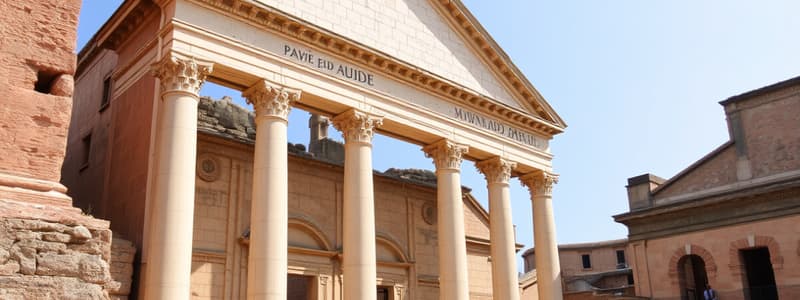Podcast
Questions and Answers
What type of religion did the Romans practice?
What type of religion did the Romans practice?
Polytheistic
Which of the following materials was commonly used in Roman architecture?
Which of the following materials was commonly used in Roman architecture?
- Tufa (correct)
- Travertine (correct)
- Marble (correct)
- Granite
The Romans developed the ARCH, VAULT, and ____.
The Romans developed the ARCH, VAULT, and ____.
DOME
The Romans were a sea-faring people.
The Romans were a sea-faring people.
What was the official language of the Roman Empire?
What was the official language of the Roman Empire?
What type of vault features two parallel walls throughout its length?
What type of vault features two parallel walls throughout its length?
Match the following architectural elements to their descriptions:
Match the following architectural elements to their descriptions:
What were the two periods of Roman history mentioned?
What were the two periods of Roman history mentioned?
Which of the following statements about Roman societal influence is true?
Which of the following statements about Roman societal influence is true?
The Roman Forum served as a meeting place and ____.
The Roman Forum served as a meeting place and ____.
Who built the first Imperial forum in Rome?
Who built the first Imperial forum in Rome?
Flashcards are hidden until you start studying
Study Notes
Roman Architecture Overview
- Roman architecture is characterized by innovative construction techniques, materials, and creative designs leading to iconic structures.
- Marble is the primary building material, distinct from Greek architecture.
Geological Influences
- Italy's strategic location in the Mediterranean facilitated the spread of art and civilization across Europe, Western Asia, and North Africa.
- Local materials available around Rome include:
- Travertine: hard limestone
- Tufa: volcanic material
- White marble: used for interiors and exteriors
- Pozzolana: a sandy earth mixed with lime to produce strong concrete.
Climate
- North Italy experiences a temperate climate.
- Central Italy is generally sunny and mild.
- Southern Italy has a nearly tropical climate.
Religion
- Roman religion is polytheistic, rooted in Roman mythology.
- Sacerdotalism (formal priesthood) plays no role in Roman religious practice.
Historical Context
- Numerous city-states existed on the Italian peninsula, with Rome emerging as the most powerful.
- Rome eventually conquered all of Italy, forming one of history’s greatest empires.
- Rome's geographical position allowed it to dominate the northern Mediterranean.
- The Romans were not a seafaring people.
Architectural Influences and Periods
- Architectural evolution is seen in two distinct periods:
- Etruscan: influenced by early inhabitants of Central Italy.
- Roman: characterized by a constitutional republic and governance over provinces, with Latin as the official language.
Etruscan Architecture Contributions
- The Etruscans introduced the Arcuated System which featured:
- Semi-circular radiating arches.
- The Tuscan column.
- Atrium-style homes.
- Etruscan architecture remains include tombs, city walls, gateways, temples, bridges, and aqueducts.
Characteristics of Ancient Roman Architecture
- Romans combined Greek styles with unique innovations, developing arches, vaults, and domes.
- Roman society transformed from small farmers to a heavily urbanized population, driven by wealth and high population density.
- Political propaganda influenced architectural designs, serving both aesthetic and public functions.
Architectural Features
- Vastness and magnificence define Roman architecture, highlighting ostentatious displays of wealth.
- The combination ofTrabeated and Arcuated systems (columns, beams, arches) established new construction styles.
Types of Vaults
- Variations of vaults developed include:
- Tunnel vault: continuous over two parallel walls.
- Wagon vault: intersects with another vault.
- Hemispherical dome: used in circular buildings.
- Cross vault: formed by the intersection of two equal semi-circular vaults.
Column Types
- Roman architecture employed Greek orders of columns, including:
- Tuscan Order: a simplified Doric style.
- Composite Order: the most decorative column type.
Decorative Techniques
- Mosaics consist of small stones arranged to create patterns.
- Construction techniques include:
- Opus Incertum: loose small stones.
- Opus Quadratum: rectangular blocks with variable mortar joints.
- Opus Reticulatum: net-like masonry effect.
- Opus Testaceum: walls of concrete and triangular bricks.
- Opus Caementicum: known as Roman concrete.
- Opus Mixtum: a combination of Opus Reticulatum and Opus Latericium.
Examples of Roman Architecture
-
Forum: A central gathering space similar to the Greek Agora, surrounded by halls, offices, and shops.
- The Roman Forum is a rectangular plaza, while Imperial forums were monumental public squares initiated by Julius Caesar.
-
Religious Architecture:
- Temples played a vital role, exemplified by the Temple of Vesta, the most sacred shrine in Rome.
- Basilicas served as halls of justice, with the Basilica of Constantine and Maxentius being a prominent example.
Studying That Suits You
Use AI to generate personalized quizzes and flashcards to suit your learning preferences.





